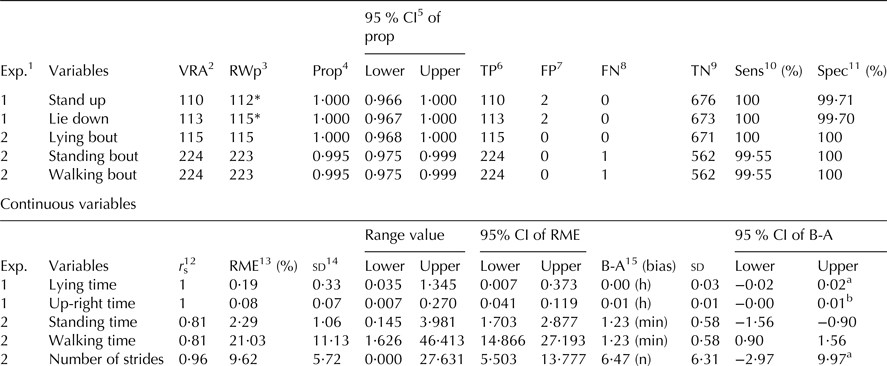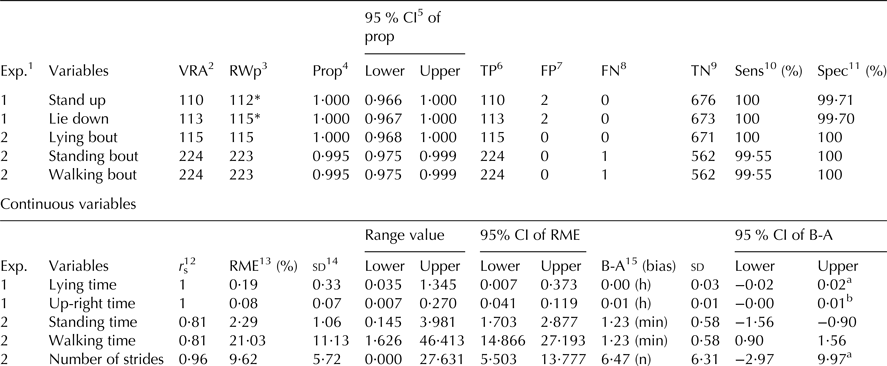Dairy cows and Mediterranean buffaloes (MB) share similar breeding systems predisposing to similar herd problems impairing animal welfare such as mastitis (Guccione et al. Reference Guccione, Cosandey, Pesce, Di Loria, Pascale, Piantedosi, Steiner, Graber and Ciaramella2014, Reference Guccione, Perreten, Steiner, Thomann, Pesce, Ciaramella and Bodmere2016a), and reproductive and foot disorders (Guccione et al. Reference Guccione, Carcasole, Alsaaod, D'Andrea, Di Loria, De Rosa, Ciaramella and Steiner2016b). As is the case for cows (Rutten et al. Reference Rutten, Velthuis, Steeneveld and Hogeveen2013), the use of automatic devices may represent a useful strategy to support herd management and to monitor health and welfare in species such as MB for which the knowledge regarding ‘disease prevention’ is truly rare (Guccione et al. Reference Guccione, Pesce, Pascale, Salzano, Tedeschi, D'Andrea, De Rosa and Ciaramella2017). As already described for cattle (Alsaaod et al. Reference Alsaaod, Niederhauser, Beer, Zehner, Schuepbach-Regula and Steiner2015, Reference Alsaaod, Luternauer, Hausegger, Kredel and Steiner2017; Beer et al. Reference Beer, Alsaaod, Starke, Schuepbach-Regula, Müller, Kohler and Steiner2016), a real-time analysis of MB walking behaviour and activity could provide useful information for early detection of lameness, thereby reducing its negative effect, increasing the chance of treatment success, and preventing the disease from becoming chronic. Considering these premises, the goal of the current investigation was to validate an algorithm of the RumiWatch® 3-dimensional accelerometer by comparing the locomotor behaviour monitored by video analysis (gold standard, GS) with the output of the accelerometers, as recently established for cattle (Alsaaod et al. Reference Alsaaod, Niederhauser, Beer, Zehner, Schuepbach-Regula and Steiner2015).
Materials and methods
The current investigation was carried out on 3 groups of 5 healthy, primiparous dairy MB (total of 15 animals) between May and October 2015. All MB were between 28 and 31 months old (29·2 ± 1·13 sd) and reared in the same breeding farm of approximately 400 MB, located in Caserta district, Southern Italy. The animals included in the study were randomly chosen from a group of 40 MB. They were individually confined in a crush and submitted to a complete clinical examination to verify the general health status, with a particular focus on claw health (i.e. absence of foot disorders and lameness), before a pedometer device (RumiWatch®, ITIN + HOCH GmbH, Bennwil, Switzerland) was attached to the hind limbs (proximal to the fetlock joint).
Each animal enrolled was unequivocally identified and moved back to its pen shared with the rest of the herd (other 35 MB). All procedures performed in this study followed the guidelines for good clinical practice and received an institutional approval by the Ethical Animal Care and Use Committee of University of Naples ‘Federico II’. The hardware used for the current investigation was the RumiWatch® pedometer (RWp) already validated for cows by Alsaaod et al. (Reference Alsaaod, Niederhauser, Beer, Zehner, Schuepbach-Regula and Steiner2015). It represents a noninvasive electronic sensor, continuously collecting data at 10 readings per second, including a 3-dimensional accelerometer. The accuracy of the device to detect spontaneous occurrence of locomotor behaviour in primiparous MB was performed comparing RumiWatch® outputs with observational data originating from the analysis of the GS. Pedometers were attached to the animals for a period of 5 d (overall monitoring phase), of which 2 d were considered as adaptation phase (data not used for the analysis) and 3 d as data acquisition phase (data used for the analysis). Two major experiments were performed. Experiment 1 validated stand up, lie down, number of lying bouts, lying time and up-right time behaviours (Online Supplementary File Table a). As the GS, four stationary digital cameras (HD-Digital Infrared System, Conceptronic, Hartmannsdorf, Germany) were placed on each corner of the paddock. The comparison between the RumiWatch® outputs and the GS was performed by means of data analysis of 24 h of useful daylight locomotor activities extracted from the overall acquisition phase (for each day of the acquisition phase, the 8-h interval from 9:00 a.m. to 5:00 p.m. was extracted). Experiment 2 was carried out to validate the behaviours observed during the up-right position: standing time, walking time, number of standing bouts, number of walking bouts, and number of strides (Online Supplementary File Table a). For this experiment, videos recorded with a hand-held digital camera were used as the GS (Nikon d3200, Nikon Corporation, Tochigi, Japan); each MB was recorded for 3 periods of 20 min, resulting in a total of 60 min used for validation of 3D loggers. Characteristics of each of the locomotor behaviours were described by Alsaaod et al. (Reference Alsaaod, Niederhauser, Beer, Zehner, Schuepbach-Regula and Steiner2015).
All variables were analysed by standard descriptive statistics, and their distribution was defined using histograms, normality plots of Q–Q and Shapiro–Wilk-test. All data were expressed as absolute numbers, percentages, mean ± sd. The different behaviours were analysed by means of proportion and 95 % confidence intervals (discrete data), a mean relative measurement error (RME) and Spearman’s rank correlation test (continuous data) as described by Alsaaod et al. (Reference Alsaaod, Niederhauser, Beer, Zehner, Schuepbach-Regula and Steiner2015). For discrete variables, sensitivity (Se) and specificity (Sp) were also assessed (Table 2). Moreover, for continuous variables, Bland–Altman analysis (Smith et al. Reference Smith, Ma and Stafford2010) were used to evaluated differences observed between the output of video recording analysis (VRA) and RWp. A dedicated statistical software was used (SPSS, Version 17·0, Chicago, IL), and probabilities <0·05 were considered as significant.
Results
Descriptive data obtained from both the experiments are shown in Table 1. For discrete variable proportions, Se and Sp are reported in Table 2. Two episodes of body scratching (~10 s each one) were misclassified by the devices (Table 2). RME, correlation and agreement between continuous variables were also reported in detail in Table 2 (and are represented as Bland–Altman plots in Online Supplementary File Figure a).
Table 1. Overall number of events, mean and standard deviation observed in 15 primiparus dairy Mediterranean buffaloes during experiments 1 and 2

All data were generated by the RumiWatch® pedometer and compared with those obtained from video recording analyses (gold standard).
1, experiment; 2, video recording analysis; 3, RumiWatch® pedometer *Two times, a prolonged activity of body scratching performed by one buffalo with the leg equipped with the pedometer, was misclassified as a lie down and stand up event by the device.
Table 2. Numbers, proportions, Se and Sp, correlations, relative measurement errors and Bland–Altman analysis of the variables validated in 15 primiparus dairy Mediterranean buffaloes

All data were generated by the RumiWatch® pedometer and compared with those obtained from video recording analyses (gold standard)
1, experiment; 2, video recording analysis; 3, RumiWatch® pedometer; 4, proportion; 5, confidence interval (95 %); 6, true positive values; 7, false positive values; 8, false negative values; 9, true negative values; 10, sensitivity = true positive/true positive + false negative; 11, specificity = true negative/false positive + true negative; 12, Spearman's correlation coefficient: r s ≥ 0·9 were scored as very high, r s between 0·89 and 0·68 as high, between 0·67 and 0·36 as moderate, and r s ≤ 0·35 as weak; 13, mean relative measurement error = (100/video-recording observation) × absolute value (video-recording observation − RumiWatch® observation); 14, standard deviation; 15, Bland–Altman analysis used to evaluated differences (bias) observed between the overall estimates output of the VRA and RWp; a, n°1 values (6·6 %) outside the interval of confidence; b, n°2 values (13·3 %) outside the interval of confidence
* Two prolonged activities of body scratching performed by one buffalo with the leg equipped with the pedometer, were misclassified as a lie down and stand up event by the device
Discussion
To the best of the authors’ knowledge, this is the first time that any pedometer device has been validated in MB. Regarding the detection of the events lying time and up-right time, the device was very accurate (Table 2), as shown in previous studies performed in cows (Alsaaod et al. Reference Alsaaod, Niederhauser, Beer, Zehner, Schuepbach-Regula and Steiner2015). The mean differences detected by Bland and Altman analysis and by RME showed that total lying time and up-right time measured by RWp were almost identical to the values detected by VRA (Table 2, Online Supplementary File Figure a). Activities such as lying bout, stand up and lie down were always correctly detected (Table 2). The Sp of the device regarding lie down and stand up was not perfect, because of the presence of two false positive events caused by a misclassification of two episodes of prolonged body scratching not previously described in similar studies in cows. As a consequence, the algorithm was not designed to properly recognise this specific behaviour. One standing and one walking bout observed at VRA were not detected by the algorithm (Table 2). As reported by Alsaaod et al. (Reference Alsaaod, Niederhauser, Beer, Zehner, Schuepbach-Regula and Steiner2015), a walking bout is defined as at least 3 consecutive strides in the same direction (forward or backward). The period between 2 strides must not exceed 4 s. Walking bouts are rated as separate, if the time between 2 strides exceeds 10 s (Supplementary Table a). One, particularly short, stride of a series of 3 continuous strides was not detected by the algorithm, thereby missing the detection of one walking bout. In order to define a standing bout, the animal has to spend at least 20s in up-right position without walking (Alsaaod et al. Reference Alsaaod, Niederhauser, Beer, Zehner, Schuepbach-Regula and Steiner2015; Online Supplementary File Table a). Two standing bouts were misclassified as just one, because one walking bout (as described before) was not identified as such. The two previous circumstances, combined with the human error to exactly define when a MB stops walking and starts walking again, may also have contributed to produce the difference observed (RME and Bland–Altman; Table 2, Online Supplementary File Figure a) for standing time, despite a high correlation between data. The results observed were similar to a previous study recently performed in cows (RME = 4·70 %, Alsaaod et al. Reference Alsaaod, Niederhauser, Beer, Zehner, Schuepbach-Regula and Steiner2015). Concerning the number of strides, as described for cows (RME = 6·23 %, r s = 0·98; Alsaaod et al. Reference Alsaaod, Niederhauser, Beer, Zehner, Schuepbach-Regula and Steiner2015), a moderate mean RME and a very high correlation between the data obtained were observed in MB (Table 2). As previously described, the walking behaviour of the animals may not always be regular, and in rare events, characteristics of the strides were not within the time limits used by the device to identify them (e.g. in case of very short strides), finally generating the difference observed and also confirmed by the Bland and Altman analysis (Table 2, Online Supplementary File Figure a). The device records the walking activity in 10-s segments (Online Supplementary File Table a) and, for example, if the MB performs 4 strides between two consecutive segments of recording (2 in the first segment and 2 in the second one), none of them will be detected by the pedometer as parts of a walking bout, because the minimum number of strides (>3) has not been achieved in either of the recording intervals of 10 s. This condition may have affected the estimation of number of strides and of the walking time. Strides not properly recognised correspond to a decrease of the overall walking time generating the moderate mean RME recorded. As suggested by Trenel et al. (Reference Trenel, Jensen, Decker and Skjoth2009), the difference between the results given by the RWp and the GS regarding this variable may be exacerbated by an unavoidable human error/uncertainty to accurately define the beginning and the end of a walking bout.
Conclusion
As described for cows, the RumiWatch® algorithm allows the accurate detection of several characteristics of the locomotor behaviour also in MB. RWp could represent the basis for a future early and real-time disease warning system aiming to gain higher health standards in these ruminants.
Supplementary material
The supplementary material for this article can be found at https://doi.org/10.1017/S0022029917000668.
Conflict of interest
The Authors declare no known conflict of interest.




